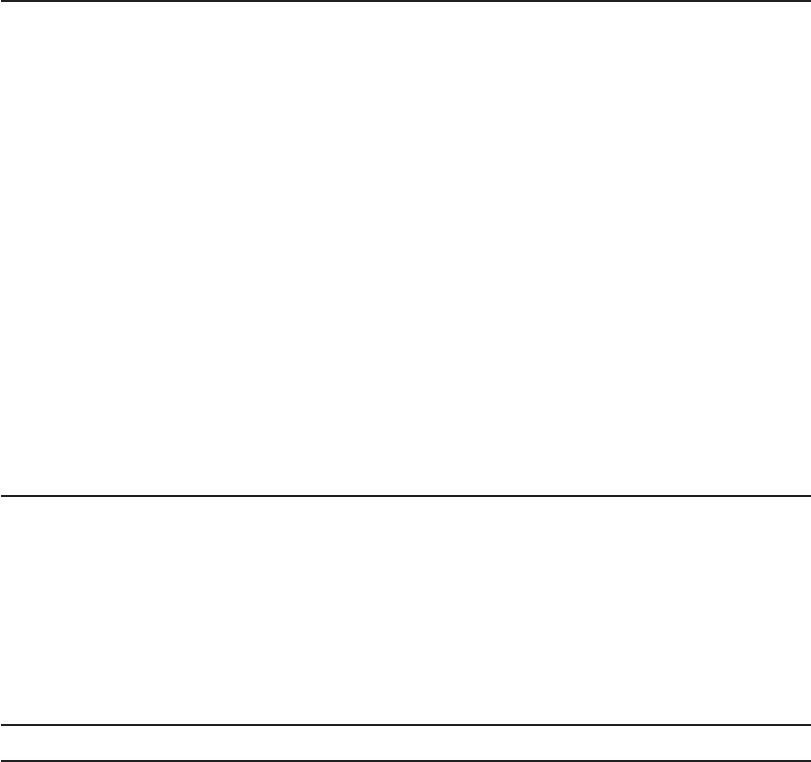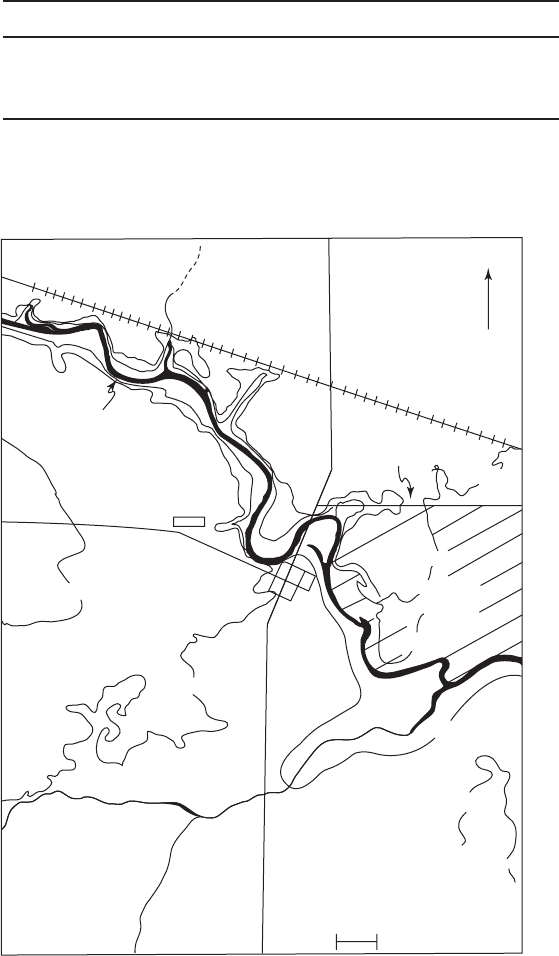Water and Wastewater Engineering
Подождите немного. Документ загружается.


18-18 WATER AND WASTEWATER ENGINEERING
Class B:
The requirements in one of the three alternatives below must be met in addition to Class B site restrictions
for the application of biosolids to land.
Alternative 1 Monitoring of indicator organisms: test for fecal coliform density as an indicator
for all pathogens at the time of biosolids use or disposal
Alternative 2 Use of PSRP: biosolids are treated in one of the processes to signifi
cantly
reduce pathogens (PSRP)
Alternative 3 Use of processes equivalent to PSRP: biosolids are treated in a process
equivalent to one of the PSRPs, as determined by the permitting authority
TABLE 18-13 (continued)
Pathogen reduction alternatives
Source: U.S. EPA (1992).
TABLE 18-14
Processes to further reduce pathogens (PFRPs) listed in Appendix B of 40 CFR Part 503
1. Composting
Using either the within-vessel composting method or the static aerated pile composting method, the
temperature of the sewage sludge is maintained at 55C (131F) or higher for 3 days.
Using the windrow composting method, the temperature of the sewage sludge is maintained at
55C
(131F) or higher for 15 days or longer. During the period when the compost is maintained at
55C (131F) or higher, there shall be a minimum of five turnings of the windrow.
2. Heat drying
Sewage sludge is dried by direct or indirect contact with hot gases to reduce the moisture content of the
sewage slu
dge to 10% or lower.
Either the temperature of the sewage sludge particles exceeds 80C (176F) or the wet bulk temperature of
the gas in contact with the sewage sludge as the sewage sludge leaves the dryer exceeds 80C (176F).
3. Heat treatment
Liquid sewage sludge is heated to a temperature of 180C (356F
) or higher for 30 minutes.
4. Thermophilic aerobic digestion
Liquid sewage sludge is agitated with air or oxygen to maintain aerobic conditions and the mean cell
residence time (i.e., the solids retention time) of the sewage sludge is 10 days at 55C (131F) to 60C (140F).
5. Beta ray irradiation
Sewage sludge is irradiated with beta rays fro
m an electron accelerator at dosages of at least 1.0 megarad
at room temperature (ca. 20C [68F]).
6. Gamma ray irradiation
Sewage sludge is irradiated with gamma rays from certain isotopes, such as Cobalt 60 and Cesium 137, at
dosages of at least 1.0 megarad at room temperature (ca. 20C [68F]).
7. Pasteurization
The temperat
ure of the sewage sludge is maintained at 70C (158F) or higher for 30 minutes or longer.
Source: U.S. EPA (1992).

GENERAL WASTEWATER COLLECTION AND TREATMENT DESIGN CONSIDERATIONS 18-19
Sludges meeting the Class A pathogen densities may be land -disposed immediately. Time
restrictions are placed on harvesting crops, grazing of animals, and public access to sites on
which Class B sludge is applied. These are summarized in Table 18-16 .
TABLE 18-15
Processes to significantly reduce pathogens (PSRPs) listed in Appendix B of 40 CFR Part 503
1. Aerobic digestion
Sewage sludge is agitated with air or oxygen to maintain aerobic conditions for a specific mean cell
residence time (i.e., solids retention time) at a specific temperature. Values for the mean cell residence
time and temperature shall be between 40 days at 20C (68F) and 60 days at 15
C (59F).
2. Air drying
Sewage sludge is dried on sand beds or on paved or unpaved basins. The sewage sludge dries for a minimum
of 3 months. During 2 of the 3 months, the ambient average daily temperature is above 0C (32F).
3. Anaerobic digestion
Sewage sludge is treated in the ab
sence of air for a specific mean cell residence time (i.e., solids retention
time) at a specific temperature. Values for the mean cell residence time and temperature shall be between
15 days at 35C (95F) to 55C (131F) and 60 days at 20C (68F).
4. Composting
U
sing either the within-vessel, static aerated pile, or windrow composting methods, the temperature of the
sewage sludge is raised to 40C (104F) or higher and remains at 40C (104F) or higher for 5 days. For
4 hours during the 5-day period, the temperature in the compost pile exceeds 55C (131F).
5. Lime stabilization
Sufficient lime is added to the sewage sludge to raise the pH of the sewage sludge to 12 after 2 hours
of contact.
Source: U.S. EPA (1992).
Restrictions for the harvesting of crops and turf
1. Food crops with harvested parts that touch the biosolids/soil mixture and are totally above ground shall
not be harvested for 14 months after application of biosolids.
2. Food crops with harvested parts below the land surface where biosolids remains on the land surface
for 4 months or longer prior to inc
orporation into the soil shall not be harvested for 20 months after
biosolids application.
3. Food crops with harvested parts below the land surface where biosolids remains on the land surface for
less than 4 months prior to incorporation shall not be harvested for 38 months after biosolids application.
4. Food crops, feed crops, an
d fiber crops whose edible parts do not touch the surface of the soil shall not
be harvested for 30 d after biosolids application.
5. Turf grown on land where biosolids are applied shall not be harvested for 1 year after application of
the biosolids when the harvested turf is placed on either land with a high potential for public exposure
or a lawn, unless otherwise spec
ified by the permitting authority.
TABLE 18-16
Site restrictions for Class B biosolids
(continued)

18-20 WATER AND WASTEWATER ENGINEERING
Restriction for the grazing of animals
1. Animals shall not be grazed on land for 30 d after application of biosolids to the land.
Restrictions for public contact
1. Access to land with a high potential for public exposure, such as a park or ball field, is restricted for
1 year after biosolids application. Examples of restricted access include posting with no trespassing
signs or fencing.
2. Access to land with a low potential for public exposure (e.g., private farmland) is restricted for
30 d after biosolids application. An example of restricted access is remoteness.
Source: U.S. EPA, 1992.
TABLE 18-16 (continued)
Site restrictions for Class B biosolids
Vector Attraction Reduction
Vectors are insects (or other animals) that transmit disease. The organic nature of sludge often
attracts vectors after the sludge is land-applied. The 503 regulations provide 11 alternatives to
reduce vector attraction. These are described in Table 18-17 .
18-5 PLANT SIZING AND LAYOUT
Once the preliminary selection of the wastewater treatment unit operations and processes has
been made (the screening process discussed in Chapter 1), rough calculations are mad e to
determine sizes to be used in examining feasibility of site locations and cost. The elements to be
con
sidered in plant sizing include: (1) number and size of process units and (2) number and size
of ancillary structures. The layout should include: (1) provision for expansion, (2) connection to
the transportation net, (3) connection to the wastewater collection system, (4) effluent discharge
location, and (5) residuals handling system.
Number and Size of Process Units
To ensure the provision of wastewater treatment, in general, a minimum of two units is provided
for redundancy. When only two units are provided, each shall be c apable of meeting the plant
design capacity. There are actually two design capacities. The first is the design process flow
capacity that is use
d to design processes such as ac tivated sludge. The second is the hydraulic
flow capacity that is used to size pumping facilities and physical facilities such as bar racks and
screens. The EPA’s design guidanc
e is summarized in Table 1-4 in Chapter 1. Consideration
should also be given to the efficiency/effectiveness of the process units with the low flows at
start-up of the facility and other low flow periods. Nighttime flows and loss of a major contribu-
tor because of relocation or failure of a business are other examples of low flow conditions that
frequently occur.
Number and Size of Ancillary Units
The ancillary units include: administration building, laboratory space, storage tanks, mechanical
building for pumping facilities, roads, and parking. The size of these facilities is a function of the

18-21
Requirement What is required?Most appropriate for:
Option 1
503.33(b)(1)
At least 38% reduction in volatile solids
during sewage sludge treatment
Sewage sludge processed by:
• Anaerobic biological treatment
• Aerobic biological treatment
• Chemical oxidation
Option 2
503.33(b)(2)
Less than 17% additional volatile solids
loss
during bench-scale anaerobic batch
digestion of the sewage sludge for
40 additional days at 30C to 37C
(86F to 99F)
Only for anaerobically digested sewage sludge
that cannot meet the requirements of Option 1
Option 3
503.33(b)(3)
Less than 15% additional volatile solids
redu
ction during bench-scale aerobic
batch digestion for 30 additional days
at 20C (68F)
Only for aerobically digested sewage sludge with
2% or less solids that cannot meet the requirements
of Option 1—e.g., sewage sludges treated
in extended aeration plants
Option 4
503.33(b)(4)
SOUR at 20C (68F) is
1.5mg oxygen/
hr/g total sewage sludge solids
Sewage sludges from aerobic processes (should
not be used for composted sludges)
Option 5
503.33(b)(5)
Aerobic treatment of the sewage sludge for
at least 14 days at over 40C (104F) with
an average temperat
ure of over
45C (113F)
Composted sewage sludge (Options 3 and 4 are likely
to be easier to meet for sludges from other aerobic
processes)
Option 6
503.33(b)(6)
Addition of sufficient alkali to raise the pH
to at least 12 at 25C (77F) and maintain
a pH 12 for 2 hours and a pH 11.5
for 22 more hour
s
Alkali-treated sewage sludge (alkalies include lime,
fly ash, kiln dust, and wood ash)
Option 7
503.33(b)(7)
Percent solids 75% prior to mixing with
other materials
Sewage sludges treated by an aerobic or anaerobic
process (i.e., sewage sludges that do not contain
unstabilized
solids generated in primary wastewater
treatment)
Option 8
503.33(b)(8)
Percent solids 90% prior to mixing with
other materials
Sewage sludges that contain unstabilized solids
generated in primary wastewater treatment
(e.g., any heat-dried sewage sludges)
Option 9
503.33(b)(9)
Sewage sludge i
s injected into soil so that
no significant amount of sewage sludge
is present on the land surface 1 hour after
injection, except Class A sewage sludge,
which must be injected within 8 hours
after the pathogen reduction process.
Sewage sludge applied to the land or placed on
a surface dis
posal site. Domestic septage applied
to agricultural land, a forest, or a reclamation
site, or placed on a surface disposal site
Option 10
503.33(b)(10)
Sewage sludge is incorporated into the soil
within 6 hours after application to land
or placement on a surface disposal site,
except Class A sewage sludge, which
must be applied to or placed on the land
surface within 8 hours after the pathogen
reduction process.
Sewage sludge applied to the land or placed on
a surface disposal site. Domestic septage applied
to agricultural land, a forest, or a reclamation site,
or placed on a surface disposal site
Option 11
503.33(b)(11)
Sewage sludge placed on a surface disposal
site must be covered with soil or other
material at the end of each operating day.
Sewage sludge or domestic septage placed on a surface
disposal site
TABLE 18-17
Summary of requirements for vector attraction reduction under Part 503
Source: U.S. EPA, 1992.

18-22 WATER AND WASTEWATER ENGINEERING
size of the plant. In small- to medium-sized facilities, particularly in cold climates and when land
is expensive, administration, laboratory, pumping and storage are housed in one building.
The storage tanks include those for chemicals and, in some instances, fuel. Space for storage
of chemical residuals must also be provided.
Plant Layout
When space is not a constraint, a linear layout generally allows the maximum flexibility for
expansion. Redundancy is enhanced if the units are interconnected in such a way that the flow
through the plant can be diverted from one treatment train to another. Because chemicals must be
delivered to the plant, conne
ction to the transportation net becomes an integral part of the layout.
Likewise, because residuals are generally transported offsite, the residuals handling system is an
integral part of the plant layout. The plant layout should minimize in-plant pumping.
18-6 PLANT LOCATION
I deally a site comparison study will be performed after alternatives have been screened and rough
sizing of the processes is complete. Many factors may preclude the ideal situation. For example,
in highly urbanized areas the availability of land may preclude all but one site. In so
me cases the
availability of land may force the selection of processes that fit into the available space.
Given that more than one site is available, there are several major issues to be considered.
As noted in Chapter 1, cost is a major element in the selection process. The site should allow
for expansion. The location of the plant relative to the receiving water for dispo
sal of the treated
wastewater, the service area, and the transportation net should be weighed carefully. The physi-
cal characteristics of the site alternatives that must be evaluated inclu de the potential for flood-
ing, foundation stability, groundwater intrusion, and the difficulty in preparing the site. Because
the hydraulics of the colle
ction system is primarily governed by the ground slope, the treatment
facility is often placed at the lowest possible elevation. The soils and groundwater table at these
sites should be examined carefully for foundation stability. Other issues to be considered include
wetland
infringement, the availability of alternate, independent sources of power, waste disposal
options, public acceptance (particular attention must be paid to odor control), and security.
Visit the text website at www.mhprofessional.com/wwe for supplementary materials
and a gallery of photos.
18-7 CHAPTER REVIEW
When you have completed studying this chapter, you should be able to do the following without
the aid of your textbook or notes:
1 . Explain why wastewater flow estimates for the components of wastewater flow should
be made separately.
2. Explain the difference between infiltration and inflow to a citizen’s group.
3. Explain why infiltration rates for new sewers are expected to be lower than for old
existing sewers.
GENERAL WASTEWATER COLLECTION AND TREATMENT DESIGN CONSIDERATIONS 18-23
4. Compare the physical characteristics of fresh sewage and septic sewage.
5. Distinguish between conventional and nonconventional pollutants.
6. State the BOD
5
, suspended solids, and fecal coliform concentrations that are often cited
as a definition of secondary treatment.
7. Explain why industries are required to pretreat wastewater before discharging to
municipal sewers.
8. Discuss a design strategy to address the issue of low flow at the s
tart-up of a new
wastewater treatment plant.
9. Discuss the conflicting desirability of locating the wastewater treatment plant at a low
elevation and the potential soil and groundwater problems in construction at such a site.
W ith the aid of this text, you should be able to do the following:
10. Estimate the wastewater flow from commercial, institutional, and recreational facilities
based on
characteristic units such as occupancy, seats, guests, beds, and so on.
11. Estimate the wastewater flow reduction that may be obtained by requiring the use of
water saving devices.
12. Estimate the average daily, maximum day, peak hour, and
minimum flow for domestic
wastewater production.
13. Estimate the infiltration flow rate for a given area with old or new sewers.
14. Estimate the infiltration flow rate for a given length of pipe.
15. Using topographic maps, select likely locations for a wastewater treatment plant.
18-8 PROBLEMS
18-1. Estimate the average and peak hour wastewater flow rate for Camp Swampy. State
all assumptions. The facility composition is shown below.
a . Camp with central toilet and bath facilities—350 campers
b. Staff cottages with private bath, two people per cottage—40 staff members
c. Dining hall serves three meals per day to campers and s
taff
18-2. A proposal to build Hotel California is being evaluated to estimate wastewater flow
rates. Two proposals are being considered. Estimate the average and peak hour
wastewater flow rate for each proposal. State all assumptions. The owner has asked
two questions:
(1) What is the impact on wastewater flow rate of having a bar with the restaurant?
(2) With respect to wastewater flow, are there an
y economies of scale?
The proposals are outlined in the table below. Assume an average occupancy of 80%, 1.5
people per room, and a maximum occupancy of 100%, 2 people per room.

18-24 WATER AND WASTEWATER ENGINEERING
Unit Proposal A Proposal B
Guest rooms 120 240
Number of employees 12 17
Self-service laundry machines 24
Restaurant, no bar, seats 80 120
Restaurant, with bar, seats 100 160
18-3. Repeat Problem 18-1 assuming the following water saving features are introduced:
a . Low-flush toilets that reduce flow from 73 to 35 L/capita · d.
b. Limiting flow shower head that reduces flow from 50 to 42 L/capita · d.
c. Energy-saver dishwasher that saves 10 L/meal.
18-4. Repeat Problem 18-2 assuming the following water saving features are intro
duced:
a . Low-flush toilets that reduce flow from 73 to 35 L/capita · d.
b. Limiting flow shower head that reduces flow from 50 to 42 L/capita · d.
18-5. Analyze Xenia’s wastewater flow rate data to estimate the following: average daily
flow rate, estimated maximum day, estimated peak hour, minimum
day, and dry
weather flow. Assume the dry season occurs from the beginning of May to the end of
September. (Data from Metcalf & Eddy, 2003.)
Xenia’s flow data, m
3
/d
Year 2006 2007
Population 8,690 9,400
Month
January 8,800 13,900
February 6,200 9,900
March 6,800 8,100
April 4,000 4,200
May 4,000 5,700
June 3,600 3,600
July 2,400 2,600
August 2,000 1,500
September 2,800 2,000
October 3,200 4,800
November 4,800 3,200
December 5,200 6,700
18-6. Analyze Eau Gaullie’s wastewater flow rate data to estimate the following: average
daily flow rate, estimated maximum day, estimated peak hour, minimum day, and

GENERAL WASTEWATER COLLECTION AND TREATMENT DESIGN CONSIDERATIONS 18-25
dry weather flow. Assume the dry season occurs from the beginning of May to the
end of September. (Data from Metcalf & Eddy, 2003.)
Eau Gaullie’s flow data, m
3
/d
Year 2008 2009
Population 11,030 12,280
Month
January 8,300 10,000
February 11,800 18,400
March 9,400 13,000
April 6,500 5,000
May5,300 7,600
June 4,800 4,600
July 3,300 3,800
August 3,800 3,100
September 2,800 2,200
October 4,400 4,400
November 6,000 6,500
December 7,300 8,600
18-7. Use Figure 2-1 to estimate the peak hour flow rate for the data from Problem 18-5 .
18-8. Use Figure 2-1 to estimate the peak hour flow rate for the data from Problem 18-6 .
18-9. The town of Aulwaze has asked your firm to begin preliminary planning for a new
wastewater treatment plant. Based on current records, the following data have been
provided to you. The population density ha
s been and is expected to continue to be
16 people/ha. For the purpose of infiltration estimates, the sewer system after 1978
is considered to be new. Estimate the average daily and peak flow rates at the begin-
ning of the design life in 2011 and at the design life of 15 years after start-up. Use
a spreadsheet program you have written to graph the data, fit trend lines, and d
erive
curve fitting equations for population and for wastewater flow.
Village of Aulwaze population estimates and wastewater flow rates
Year 1978 1999 2009
Population 10,400 14,600 16,800
Wastewater flow rate, Lpcd 401 464 494
18-10. The Village of Royalflush has asked your firm to begin preliminary planning for a
new wastewater treatment plant. Based on current records, the following data have
been provided to you. The population density has been and is expected to continue
to be 16 people/ha. For the purpose of infiltration estimates, the sewer system after

18-26 WATER AND WASTEWATER ENGINEERING
1980 is considered to be new. Estimate the average daily and peak flow rates at the
beginning of the design life in 2011 and at build out in 2030. The build-out popula-
tion is estimated to be about 1,700. Use a spreadsheet program you have written to
graph the data, fit trend lines, and derive curve fitting equations for population and
for wastewater flow.
Village of Royalflush population estimates and wastewater flow rates
Year 1973 1980 1990 2000 2009
Population 1,400 1,380 1,420 1,510 1,630
Wastewater flow
rate, Lpcd
380 385 475580 680
18-11. On a copy of the map for LaNeige Fondue and vicinity, identify potential sites for a
new WWTP. The WWTP will treat wastewater from the village, the biofuel plant,
and the retirement center.The 100-year flood elevation is along the 480 m contour.
M - 65
PDQ
RR
485 m
N
Moselle
River
Mt Blank Rd
480 m
Cre
ek
Two Lake
485 m
Biofuel
Plant
500 m
La Neige
Fondue
Mud Lake Drain
Pine Lake Drain
M.L.D
11 JAN 2008
M - 65
485 m
La Neige Fondue and
Vicinity
Scale :
100 m
Contour interval = 5 m
Bastogne
Center
480 m
Retirement
FIGURE P-18-11

GENERAL WASTEWATER COLLECTION AND TREATMENT DESIGN CONSIDERATIONS 18-27
18-12. On a copy of the map for Waffle and vicinity, identify potential sites for a new
WWTP. The WWTP will treat wastewater from the village and the brewery. The
100-year flood elevation is along the 120 m contour.
136
Brewery
120
112
96
109
112
96
96
112
120
128
120
104
196
120
Waffle
128
128
136
136
120
120
Scale
200 m
Contour interval = 8 m
Waffle and Vicinity
MLD
1 MAR 2008
S
y
r
u
p River
ce
m
96
N
Bl
u
eberr
y
Creek
104
Coffee Creek
M
a
p
l
e
B
r
a
n
c
h
FIGURE P-18-12
18-9 DISCUSSION QUESTIONS
18-1. A local service organization has asked you to make a presentation about a city
proposal to address the issue of combined sewer overflow. Prepare one or two
PowerPoint graphics that you will use to show the difference between infiltration
and inflow.
18-2. In the following list of pollutants mark those that are conventional with a “C” and
those that are nonconventional with “NC.”
a . Chromium VI
b. pH
c. TSS
d. Phenol
e.
Oil and grease
